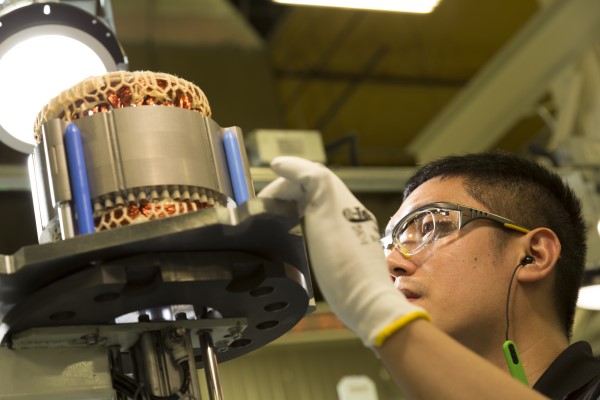Texas Academy Builds Statewide Network to Drive Effective Workforce Development
Published Sep 23, 2020 by Susan Moore
Amid the pandemic and significant job loss across Houston and Texas, workforce development stakeholders from regions across the state have come together (virtually) to learn proven strategies for building sustainable talent pipelines that will help Texans access greater economic opportunity and help employers tap into high-quality talent.
In April, the U.S. Chamber of Commerce Foundation launched the Talent Pipeline Management® (TPM) Academy of Texas, a six-month-long program designed to teach existing leaders how to better drive partnerships with educational and training providers based on industry need and to improve career pathways for the current workforce and individuals just entering it. It is supported in the state by an alliance of state workforce and education leaders, including the Partnership, Educate Texas and the Federal Reserve Bank of Dallas. TPM® academies have also been held in other states including Michigan, Arizona, Kentucky and North Carolina (previous cohorts have had national representation, too), but as one of the largest states in population, geography and economy, Texas faces workforce challenges across its diverse regions that combine into a similarly superlative need for skilled talent.
TPM® is a demand-driven, employer-led approach to closing the skills gap. It encourages employers to undertake an “extended leadership role as ‘end-customers’ of education and workforce partners.” The TPM framework is comprised of six strategies that build off one another and support employers in developing data- and performance-driven approaches to improving education and workforce partnerships: organizing employer collaboratives; engaging in demand planning; communicating competency and credential requirements; analyzing talent flows; building talent supply chains; and continuously improving.
A Texas-centric TPM Academy® provides a great opportunity for these diverse regions with different economic drivers to work together to address critical workforce issues and strengthen the state’s overall competitiveness. In addition, this work will benefit Texas as it works to achieve its 60x30TX goal – to have at least 60 percent of Texans between 25 and 34 years old to hold a certificate or degree by the year 2030. With nearly 1 million unemployed Texans in August 2020, the TPM strategies can assist cities and regions in their recovery and strengthening the skills of individuals.
“The TPM Academy® of Texas is laying a statewide groundwork to build the employer and business leadership necessary to increase alignment and strengthen local and regional capability to address the skills gap,” says Greater Houston Partnership Senior Vice President of Regional Workforce Development Peter Beard, who serves as Academy faculty. “UpSkill Houston has used the TPM strategies to strengthen employer leadership in Houston and build stronger partnerships with education and community partners.”
Thirty individuals representing local chambers of commerce, non-profits and colleges, consultancies and economic development agencies are participating in the Texas cohort including regional members. Bryant Black, Partnership director of Regional Workforce Development; UpSkill Houston executive committee members Dr. Allatia Harris, vice chancellor of Strategic Initiatives – Workforce, Community Relationships and Diversity, and Andrew Van Chau, executive board member of the Gulf Coast Economic Development District and Katy-Fulshear Area Chamber of Commerce; and Keri Schmidt, president and CEO of the Fort Bend Chamber. Others participating also hail from Austin, Beaumont, Dallas, El Paso, Lubbock, San Antonio, Texarkana, and Waco, among other cities, large and small. The Texas cohort has begun work to address workforce needs in key industries including health care, advanced manufacturing and aerospace.
In addition to Beard, faculty include Jaimie Francis, executive director, and Niki DaSilva, manager, at the U.S. Chamber of Commerce Foundation’s Center for Education and Workforce. Other faculty members include the authors of the TPM Academy curriculum, Jason Tyszko, U.S. Chamber of Commerce Foundation Vice President for the Center for Education and Workforce, and Robert G. Sheets, George Washington Institute of Public Policy research professor, as well as other renowned workforce development leaders from across the country. Recently, the Center for Education and Workforce released a Resource Guide for High-Quality CTE (Career and Technical Education) to build stronger employer and CTE partnerships and a Resource Guide for Connecting Opportunity Population Talent to Better Career Pathways.
“The TPM Academy has allowed for all the regions of the state to convene and identify shared challenges and opportunities, and you are already seeing collaborations sprout from our time together. Moving forward this will only be a positive thing for the state as we look to address new encounters on the horizon,” Black said, adding that rapid changes to the state’s economy will have implications what jobs are in demand and on the way work is done.
By coming together at the state level, Texas leaders have the opportunity to build local and regional networks – colleagues with different knowledge and skills who you can pick up the phone and call, as Harris puts it – while also gaining access to the wider national network of TPM practitioners through the Chamber Foundation’s National Learning Network. It can also help drive smart workforce development policy at a state level, said Van Chau. He called the TPM® model tried and tested, sustainable and responsive to changing labor market needs. Van Chau had been familiar with the TPM® principles before joining the Texas cohort and pointed out that the TPM Academy reinforced the critical importance for workforce development to be employer driven. What is most needed is buy-in from the top.
Angela Robbins-Taylor, director of Construction Career Collaborative (C3) and a TPM Academy graduate with a previous cohort, sees the TPM strategy as a powerful tool that forces employers to drive decisions based on data and to plan beyond the present, something she says doesn’t always happen in the construction industry. It forces employers to think about talent differently – like a supply chain. Employers have to think about the specific skills they need their workforce to have, where they can find that talent and how they can build a pipeline for that talent.
Once employers identify what they need and have a common vocabulary for it, they are better able to collaborate with partners to train workers and a future workforce, said Harris, of San Jacinto College.
Colleges and other players cannot look at each other as competitors, but instead must recognize their role in a functioning system, she said. As an educational institution, a college’s goal is to listen to what employers need. Following the TPM curriculum has helped her think outside the bounds of her organization.
“I can ask better questions. I can listen better. I can understand different opportunities to help an employer build out the workforce needed,” she said.
The TPM strategy improves communication between all parts of workforce development, she added.
“When that happens, that pipeline will flow,” Harris said.
Learn more about the TPM Academy here.
 The Houston Report
The Houston Report




















